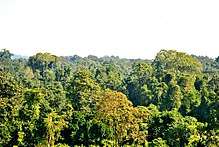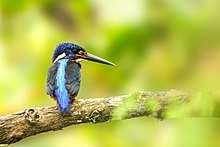Dehing Patkai Wildlife Sanctuary

Dehing Patkai Wildlife Sanctuary is located in the Dibrugarh and Tinsukia Districts of Assam and covers an area of 111.19 km2 (42.93 sq mi) rainforest.[1] It is part of the Assam valley tropical wet evergreen forest and consists of three parts: Jeypore, upper Dihing River and Dirok rainforest. It was declared a sanctuary on 13 June 2004. This sanctuary is also a part of Dehing-Patkai Elephant Reserve. The rainforest stretches for more than 575 km2 (222 sq mi) in the districts of Dibrugarh, Tinsukia and Sivasagar. A part of the forest was declared as a wildlife sanctuary by the Government of Assam, while another part falls under the Dibru-Deomali Elephant Reserve. The forest further spreads over in the Tirap and Changlang districts of Arunachal Pradesh. The Dehing Patkai forms the largest stretch of tropical low-land rainforests in India. The forest is often referred as "The Amazon of the east" owing to its large area and thick forests.
The area has several historic attractions, including World War II cemeteries, the Stillwell road and the Digboi refinery, the oldest in Asia.
Climate
The climate of the region is mostly tropical with annual rainfall of more than 4,000 mm. Monthly precipitation is at least 60 mm.
Wildlife
Fauna
Being a completely virgin rainforest, this sanctuary is very rich in biodiversity. It is an ideal habitat for non-human primates. Till date, 47 mammal species, 47 reptile species and 30 butterfly species have been recorded. The most common mammal species of this sanctuary are hoolock gibbon, slow loris, pig-tailed macaque, stump-tailed macaque, capped langur, Asian elephant, Bengal tiger, Indian leopard, gaur, Chinese pangolin, Himalayan black bear, Himalayan squirrel, leopard cat, clouded leopard, porcupine, crab eating mongoose, sambar, sun bear, binturong, barking deer, golden cat and marbled cat.
Avifauna

Dehing Patkai rainforest harbours about 293 bird species, belonging to 174 genera and 51 families. The majority is resident (63.7%), some are winter visitors (23.1% ), and very few are summer visitors (2.5%). About 10.7% are altitudinal migrants, coming mainly from the higher reaches of the western, central and eastern Himalayas. Avifauna includes slender-billed vulture, white-winged duck, greater adjutant, lesser adjutant greater spotted eagle, beautiful nuthatch, marsh babbler, tawny-breasted wren-babbler, yellow-vented warbler, broad-billed warbler, white-naped yuhina, white-cheeked partridge, great hornbill, brown hornbill, Oriental darter and painted stork, osprey, kalij pheasant, grey peacock pheasant, besra, black baza and hill myna.
The birds of Dehing Patkai rainforest thrive in the diversity of microhabitats in the predominantly evergreen forest such as dense evergreen forest, rivers and streams, evergreen forest edge, swamps, semi-open evergreen forest that includes the logged areas where openings are present, agriculture (cultivations, fallows and tea gardens) along the edge and habitations on evergreen forest edge. Most species are habitat specialists i.e. they are found only in a single microhabitat, with dense evergreen forest harbouring the maximum of 111 of the total 281 birds species recorded in Jeypore, of which insectivores are the most dominant guild with 79 species. 44 species were recorded along rivers or streams, 37 species in evergreen forest edge and 23 species in semi-open evergreen forest. The insectivorous, carnivorous and most of the omnivorous birds help control the insect and rodent pests in the forest as well as in the agricultural ecosystem adjoining the forest. Frugivores like the hornbills, barbets, pigeons and koel, along with some of the omnivores like crows, mynas and starlings that feed on fruits serve as seed dispersers. Nectarivores, some of the insectivores and omnivores that feed on nectar help in plant pollination. There are terrestrial piscivores like the kingfishers, brown fish owl and osprey and 31 aquatic species that depend on the rivers and streams inside the forest and the agricultural fields along the forest edge.
Flora
The different trees of this four layered rainforest are laden with many exotic species of orchids and bromeliads.There is an abundance of ferms, epiphytes, wild banana, orchids, arums, climbers and linas in this humid forest habitat. Some of the importance tree species found in this forest area are – Hollang, Mekai, Dhuna, Udiyam, Nahar, Samkothal, Bheer, Hollock, Nahor, Au – tenga (elephant apple), different species of Dimoru etc. The towering Hollong tree which is also the state tree of Assam dominates the emergent layer of this rainforest.
The forests are wet tropical evergreen Assam valley forests.
The important species of overwood are Dipterocarpus mncrocarpus, Mesua ferrea, Castanopsis indica, Shorea assamica, Vatica lanceaefolia, Amoorn wallichii, Dysoxylum hinectiferum etc. The other species found in understorey are Garcinia lanceaefolia, Michelia muni, Baccaureu supida, Bischqfia javanica, Myristica limifolia etc. The shrub and herb layer has Glochidion spp., Alpinia spp., Mallotus philippinensis, wild banana, tree fern, pepper etc. The ground cover mainly has Melnstoma, Leea and other species.
Orchids
The Dehing Patkai Forest is one of the most important forests of Assam in terms of orchid diversity. So far, 101 species of orchids within 45 genera have been recorded there. Of these, 79 are epiphytic, 21 are terrestrial and 1 species is a saprophyte. Eight of the species found here are critically endangered, 15 species are endangered, 5 species are near threatened and 28 species are in the vulnerable category. Dehing Patkai Forest has the distinction of several new orchid records for the region. Thrixspermum acuminatissimum is a new record to India; 9 species Bulbophylum ebulbum, Chrysoglossum erraticum, C. robinsonii, Eria connate, E. pudica, Hetaeria affinis, Thelasis pygmaea, Taeniophyllum crepidiforme and Zeuxine clandestine are new records from Assam; and 12 species Anoectochilus brevilabris, Bulbophyllum protractum, B. spathulatum, Calanthe lyroglossa, Ceratostylis sabulata, Cleisostoma discolor, Podochilus khasianus, Tainia minor, T. waryana, Thelasis longifolia, Trichotosia velutina, and Tylostylis discolour are new records from Upper Assam. It is important to focus conservation on species like Acanthephippium striatum, Anoectochilus brevilabris, Bulbophyllum spathulatum, Cymbidium bicolour, C. dayanum, Dendrobium nobile, Eria paniculatum, Gastrochilus calceolaris, Phalanopsis manni, P. parishii and Zeuxine clandestine that are already very rare in Dehing Patkai. Depending on the sunlight, temperature and other microhabitat requirements, orchids grow in different layers of the Dehing Patkai rainforest. Light-loving orchids like Acampe papillosa, A. rigida and Dendrobium acinaciforme grow well at the top storey up to 20-30 meter height. Species such as Aerides odoratum, Bulbophyllum affine, Cleisostoma appendiculatum and Coelogyne ovalis grow in the middle story; while shade-preferring species like Bulbophyllum delitescens, Cymbidium bicolor, and Dendrobium aduncum grow best in the lower stories of the forest. Occasionally, one may chance upon terrestrial orchids that grow in the diffused sunlight of the dense forest floor of Dehing Patkai Forest.
Ethnic groups
The Dehing Patkai Forest region has a rich cultural heritage. There are more than a dozen different ethnic groups living in the area including the indigenous Assamese communities, particularly Tai Phake, Khamyang, Khampti, Singpho, Nocte, Ahom, Kaibarta, Moran and Motok, Burmese, and non-indigenous Nepali people. Tea-tribes were brought by the British to work in the tea plantations.
References
- ↑ Dehing Patkai Wildlife Sanctuaries Department of Environment & Forests, Government of Assam, Retrieved 2 September 2015